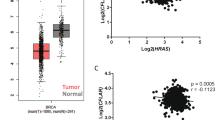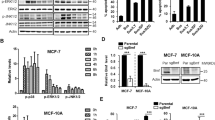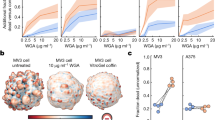Abstract
Detachment of epithelial cells from extracellular matrix results in induction of apoptosis (‘anoikis’) which can be blocked by expression of activated Ras or PKB/Akt. Here we show that detachment causes release of cytochrome c from mitochondria in MDCK cells. This is blocked by caspase inhibitors, suggesting a role for caspases upstream of mitochondria in the initiation of anoikis, in accord with the ability of dominant negative FADD to inhibit this form of cell death. Bulk activation of caspase-8 following detachment lags behind cytochrome c release, and is likely the result of a mitochondrial positive feed back loop. Matrix detachment also induces Bax translocation to mitochondria in a caspase-dependent manner. Expression of activated Ras or PKB/Akt blocks all the detectable events on the detachment-induced apoptosis signalling pathway, suggesting that PKB/Akt acts at an early point in the pathway, providing the signal normally generated by matrix attachment. Strong activation of Raf can also protect MDCK cells from detachment induced apoptosis, but this occurs at a point downstream of cytochrome c release from mitochondria, and is clearly distinct from the effect of PKB/Akt.
This is a preview of subscription content, access via your institution
Access options
Subscribe to this journal
Receive 50 print issues and online access
$259.00 per year
only $5.18 per issue
Buy this article
- Purchase on Springer Link
- Instant access to full article PDF
Prices may be subject to local taxes which are calculated during checkout




Similar content being viewed by others
References
Boudreau N, Sympson CJ, Werb Z and Bissell MJ. . 1995 Science 267: 891–893.
Cardone MH, Roy N, Stennicke HR, Salvesen GS, Franke TF, Stanbridge E, Frisch S and Reed JC. . 1998 Science 282: 1318–1321.
Datta SR, Brunet A and Greenberg ME. . 1999 Genes Dev. 13: 2905–2927.
Desagher S, Osen-Sand A, Nichols A, Eskes R, Montessuit S, Lauper S, Maundrell K, Antonsson B and Martinou JC. . 1999 J. Cell Biol. 144: 891–901.
Downward J. . 1998 Curr. Opin. Cell Biol. 10: 262–267.
Downward J. . 1999 Nature Cell Biol. 1: E33–E35.
Erhardt P, Schremser EJ and Cooper GM. . 1999 Mol. Cell. Biol. 19: 5308–5315.
Eskes R, Antonsson B, Osen-Sand A, Montessuit S, Richter C, Sadoul R, Mazzei G, Nichols A and Martinou JC. . 1998 J. Cell Biol. 143: 217–224.
Frisch SM. . 1999 Curr. Biol. 9: 1047–1049.
Frisch SM and Francis H. . 1994 J. Cell Biol. 124: 619–626.
Frisch SM, Vuori K, Ruoslahti E and Chan-Hui PY. . 1996 J. Cell Biol. 134: 793–799.
Fujita E, Jinbo A, Matuzaki H, Konishi H, Kikkawa U and Momoi T. . 1999 Biochem. Biophys. Res. Commun. 264: 550–555.
Goping IS, Gross A, Lavoie JN, Nguyen M, Jemmerson R, Roth K, Korsmeyer SJ and Shore GC. . 1998 J. Cell Biol. 143: 207–215.
Hsu YT, Wolter KG and Youle RJ. . 1997 Proc. Natl. Acad. Sci. USA 94: 3668–3672.
Kennedy SG, Kandel ES, Cross TK and Hay N. . 1999 Mol. Cell. Biol. 19: 5800–5810.
Khwaja A, Rodriguez-Viciana P, Wennstrom S, Warne PH and Downward J. . 1997 EMBO J. 16: 2783–2793.
Li H, Zhu H, Xu CJ and Yuan J. . 1998 Cell 94: 491–501.
Li P, Nijhawan D, Budihardjo I, Srinivasula SM, Ahmad M, Alnemri ES and Wang X. . 1997 Cell 91: 479–489.
Luo X, Budihardjo I, Zou H, Slaughter C and Wang X. . 1998 Cell 94: 481–490.
Maehama T and Dixon JE. . 1999 Trends Cell Biol. 9: 125–128.
Marshall CJ. . 1996 Curr. Opin. Cell Biol. 8: 197–204.
Meredith JE, Fazeli B and Schwartz MA. . 1993 Mol. Biol. Cell 4: 953–961.
Meredith JE and Schwartz MA. . 1997 Trends Cell Biol. 7: 146–150.
Rodriguez-Viciana P, Warne PH, Dhand R, Vanhaesebroeck B, Gout I, Fry MJ, Waterfield MD and Downward J. . 1994 Nature 370: 527–532.
Rodriguez-Viciana P, Warne PH, Khwaja A, Marte BM, Pappin D, Das P, Waterfield MD, Ridley A and Downward J. . 1997 Cell 89: 457–467.
Rytömaa M, Martins LM and Downward J. . 1999 Curr Biol. 9: 1043–1046.
Samali A, Cai J, Zhivotovsky B, Jones DP and Orrenius S. . 1999 EMBO J. 18: 2040–2048.
Scaffidi C, Fulda S, Srinivasan A, Friesen C, Li F, Tomaselli KJ, Debatin KM, Krammer PH and Peter ME. . 1998 EMBO J. 17: 1675–1687.
Schulze-Osthoff K, Ferrari D, Los M, Wesselborg S and Peter ME. . 1998 Eur. J. Biochem. 254: 439–459.
White MA, Nicolette C, Minden A, Polverino A, Van Aelst L, Karin M and Wigler MH. . 1995 Cell 80: 533–541.
Wolter KG, Hsu YT, Smith CL, Nechushtan A, Xi XG and Youle RJ. . 1997 J. Cell Biol. 139: 1281–1292.
Woods D, Parry D, Cherwinski H, Bosch E, Lees E and McMahon M. . 1997 Mol. Cell. Biol. 17: 5598–5611.
Author information
Authors and Affiliations
Rights and permissions
About this article
Cite this article
Rytömaa, M., Lehmann, K. & Downward, J. Matrix detachment induces caspase-dependent cytochrome c release from mitochondria: inhibition by PKB/Akt but not Raf signalling. Oncogene 19, 4461–4468 (2000). https://doi.org/10.1038/sj.onc.1203805
Received:
Revised:
Accepted:
Published:
Issue Date:
DOI: https://doi.org/10.1038/sj.onc.1203805
Keywords
This article is cited by
-
Understanding the cell survival mechanism of anoikis-resistant cancer cells during different steps of metastasis
Clinical & Experimental Metastasis (2022)
-
Identification of a novel anoikis signalling pathway using the fungal virulence factor gliotoxin
Nature Communications (2018)
-
Cancer cell survival during detachment from the ECM: multiple barriers to tumour progression
Nature Reviews Cancer (2014)
-
Involvement of α7 nAChR Signaling Cascade in Epigallocatechin Gallate Suppression of β-Amyloid-Induced Apoptotic Cortical Neuronal Insults
Molecular Neurobiology (2014)
-
A genome wide shRNA screen identifies α/β hydrolase domain containing 4 (ABHD4) as a novel regulator of anoikis resistance
Apoptosis (2012)



